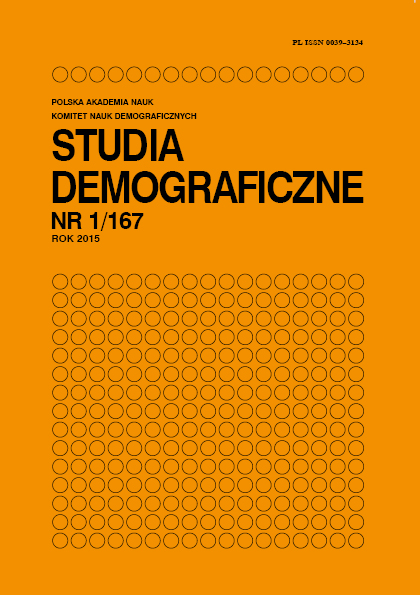Informal support for the elderly in the context of their living arrangements in selected European countries
Main Article Content
Abstract
The main objective of this paper is to analyze the informal support for the elderly experiencing problems in everyday life connected with physical, mental or emotional fitness. The analysis covers groups of countries chosen from the participants of SHARE project. The multinomial logit model has been used in order to verify the hypothesis that such problems determine the living arrangements of the elderly. The binomial regression model has been used in order to answer a question if informal support from outside the household obtained by the people experiencing problems in everyday life is determined by the type of the household and by social and demographic characteristics of the individuals receiving the support. In conclusion we state that the occurrence of difficulties in everyday life does not affect the chance of living in a one-person household. For the other types of the households the aforementioned influence turns out to be significant only for selected countries. In all investigated countries, for people experiencing difficulties in everyday life, a significant influence of the type of the household on receiving help from outside the household has been observed. In future research, a closer attention should be paid to elderly people living alone and to incorporating various types of limitations in everyday life separately for men and women. For better explanation of the differences between post-transitional and the other European countries the formal and institutional supports should be introduced.
Article Details
References
[2] Bengtson V.L., Rosenthal C.J., Burton L.M., 1990, Families and ageing: Diversity and heterogeneity, [in:] R.H. Binstock, L.K. George (eds.), Handbook of Aging and the Social Sciences, 3rd ed., Academic Press, New York, pp. 263–287.
[3] Börsch-Supan A., 2003, Labor market effects of population aging, „Review of Labour Economics and Industrial Relations”, vol. 17, pp. 5–44.
[4] Chłoń-Domińczak A. (eds.), 2014, Portret generacji 50+ w Polsce i w Europie. Wyniki badania zdrowia, starzenia się i przechodzenia na emeryturę (SHARE), Instytut Badań Edukacyjnych, http://www.researchgate.net/publication/ (dostęp 23.04.2015)
[5] de Jong Gierveld J., de Valk H., Blommesteijn M., 2001, Living arrangements of older persons and family support in more developed countries, [in:] United Nations, Population Ageing and Living Arrangements of Older Persons: Critical Issues and Policy Responses, United Nations Population Bulletin, Special Issue No. 42/43.
[6] de Jong Gierveld J., Dykstra P.A., Schenk N., 2012, Living arrangements, intergenerational support types and older adult loneliness in Eastern and Western Europe, “Demographic Research”, Special Collection, vol. 27(7).
[7] Dykstra P.A., Komter A.E., 2012, Generational interdependencies in families: The MULTILINKS research programme, „Demographic Research”, 27, 487–506.
[8] Dykstra P.A, van den Broek T., Muresan C., Haragus M., Haragus P-T., Abramowska-Kmon A., Kotowska I.E., 2013, State-of-the-art report Intergenerational linkages in families, Families and Societies, Changing families and sustainable societies: Policy contexts and diversity over the life course and across generations, Working Paper Series, no. 1, A project funded by European Union’s Seventh Framework Programme.
[9] Grotowska-Leder J., 2008, Wsparcie społeczne w perspektywie teorii socjologicznych, [w:] J. Grotowska-Leder (red.), Sieci wsparcia społecznego jako przejaw integracji i dezintegracji społecznej, Wydawnictwo Uniwersytetu Łódzkiego, Łódź.
[10] Grundy E., 2001, Living arrangements and the health of older persons in developed countries, [in:] United Nations, Population Ageing and Living Arrangements of Older Persons: Critical Issues and Policy Responses, United Nations Population Bulletin, Special Issue No. 42/43.
[11] Gruszczyński M., 2012, Mikroekonometria. Modele i metody analizy danych indywidualnych. Oficyna, Warszawa, pp. 185–196.
[12] United Nations, 2005, Informal support transfers between generations, [in:] United Nations, Living Arrangements of Older People Around the World, http://www.un.org/en/development/desa/population/publications/ageing/living-arrangements.shtml (access 15.04.2014).
[13] Kalbarczyk M., Nicińska A., 2009, Finansowe i niefinansowe transfery w próbie SHARE, „Polityka Społeczna” no. 4, pp.13–18.
[14] Knipscheer C.P.M., 1992, Interdependency among the generations within the family: A sociological approach, [in:] H. Bouma, J.A.M. Graafmans, (eds.), Gerontechnology, IOS Press, Amsterdam, pp. 39–50.
[15] Lee R., Tuljapurkar Sh., 1997, Death and taxes: How longer life will affect social security, „Demography”, 34: 67–81.
[16] Lesthaeghe R., 2010, The unfolding story of the Second Demographic Transition, „Population and Development Review”, 36 (2): 211–251.
[17] Martin, L., Culter, S., 1983, Mortality decline and Japanese family structure. „Population and Development Review”, 9 (4), pp. 633–649.
[18] Palloni A., 2001, Living arrangements of older persons, [in:] United Nations, Population ageing and living arrangements of older persons: Critical issues and policy responses, United Nations Population Bulletin, Special Issue No. 42/43.
[19] Prskawetz A., Fent T., Guest R., 2008, Workforce aging and labor productivity: The role of supply and demand for labor in G7 countries, „Population and Development and Review”, vol. 34, pp. 298–323.
[20] Puur A., Sakkeus L., Põldma A., Herm A., 2011, Intergenerational family constellations in contemporary Europe: Evidence from the Generations and Gender Survey, „Demographic Research”, vol. 25, pp. 135–172.
[21] Saraceno C., Keck W., 2008, The institutional framework of intergenerational family obligations in Europe: A conceptual and methodological overview, Wissenschaftszentrum Berlin für Sozialforschung, November 2008.
[22] Soja E., Stonawski M., 2012, Starzenie się populacji a poziom życia ludności, [w]: J. Kurkiewicz (red.) Demograficzne uwarunkowania i wybrane społeczno-ekonomiczne konsekwencje starzenia się ludności w krajach europejskich, Wydawnictwo Uniwersytetu Ekonomicznego w Krakowie, Kraków.
[23] Stanisz A., 2007, Przystępny kurs statystyki. Tom 2. Modele liniowe i nieliniowe. StatSoft, Kraków. Uhlenberg P., 1993, Demographic change and kin relationships in later life, „Annual Review of Gerontology and Geriatrics”, vol. 13, pp. 219–238.
[24] van de Kaa D.J., 1987, Europe’s second demographic transition. „Population Bulletin” 42 (1), Population Reference Bureau Inc, Washington.
[25] van de Kaa D.J., 2004, Is the second demographic transition a useful research concept? Questions and answers. „Vienna Yearbook of Population Research” 2004: 4–10.
